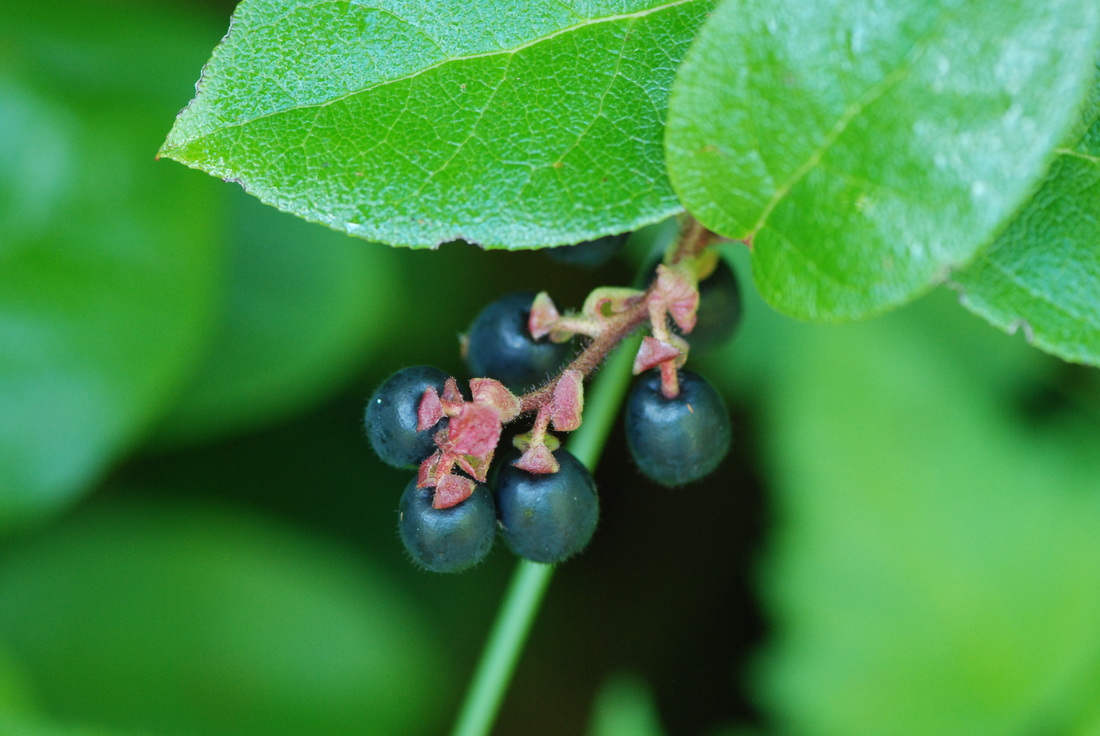Salal • Gaultheria shallon
Identification
Salal is a very common understory shrub in BC. It forms dense thickets, and is identifiable by its leathery leaves. The egg-shaped leaves, which vary somewhat in width, have pointed tips and are finely but sharply toothed. Depending on the overstory and region in which it grows, salal ranges in height from 0.5 m to 5 m tall. In the spring and early summer branch tips are adorned with rows of white to pinkish urn-shaped flowers. Later in the summer clusters of bluish-black 'berries' (which are actually fleshy sepals) form; these fruits look somewhat like oblong blueberries. Both the berries and the flowers are hairy and glandular (have gland that produce a sticky or greasy substance).
Habitat & Range
Salal grows in the understory of coniferous forests, as well as wet forests, bogs, and rocky bluffs. It's found at low to medium elevations. Its range is mostly coastal, extends along the west coast of North America from Alaska to California — though it does range inland across southern BC as well.
Human Uses
Salal berries have been used extensively by the Indigenous Peoples of the Pacific Northwest, including the Kwakwaka'wakw, Haida, and Ditidaht. The berries are abundant and were eaten fresh and dried into cakes, as well as dipped in oolichan grease (Kwakwaka'wakw), used as a sweetener, and to thicken salmon eggs (Haida).
The Ditidaht ate the young leaves as a hunger suppressant, while the leafy branches were used in pit cooking.
Intriguing Info
Salal was introduced to England, where it is known as shallon or Gaultheria, in 1828 by David Douglas for use as a garden ornamental. However, Plantlife (a UK conservation organization) considers it to be an invasive species. Birds distribute the seeds from garden plants into the wild, where it can quickly form dense thickets that exclude native vegetation. It has also been deliberately planted as cover for game on acidic soils, which assists its spread.
Salal is a very common understory shrub in BC. It forms dense thickets, and is identifiable by its leathery leaves. The egg-shaped leaves, which vary somewhat in width, have pointed tips and are finely but sharply toothed. Depending on the overstory and region in which it grows, salal ranges in height from 0.5 m to 5 m tall. In the spring and early summer branch tips are adorned with rows of white to pinkish urn-shaped flowers. Later in the summer clusters of bluish-black 'berries' (which are actually fleshy sepals) form; these fruits look somewhat like oblong blueberries. Both the berries and the flowers are hairy and glandular (have gland that produce a sticky or greasy substance).
Habitat & Range
Salal grows in the understory of coniferous forests, as well as wet forests, bogs, and rocky bluffs. It's found at low to medium elevations. Its range is mostly coastal, extends along the west coast of North America from Alaska to California — though it does range inland across southern BC as well.
Human Uses
Salal berries have been used extensively by the Indigenous Peoples of the Pacific Northwest, including the Kwakwaka'wakw, Haida, and Ditidaht. The berries are abundant and were eaten fresh and dried into cakes, as well as dipped in oolichan grease (Kwakwaka'wakw), used as a sweetener, and to thicken salmon eggs (Haida).
The Ditidaht ate the young leaves as a hunger suppressant, while the leafy branches were used in pit cooking.
Intriguing Info
Salal was introduced to England, where it is known as shallon or Gaultheria, in 1828 by David Douglas for use as a garden ornamental. However, Plantlife (a UK conservation organization) considers it to be an invasive species. Birds distribute the seeds from garden plants into the wild, where it can quickly form dense thickets that exclude native vegetation. It has also been deliberately planted as cover for game on acidic soils, which assists its spread.
References
Pojar, J. and MacKinnon, A. (2005). Plants of Coastal British Columbia, Revised. Vancouver, BC: Lone Pine Publishing. P. 53.
Authors and editors of page
Chanda Brietzke, Kelly Fretwell, and Brian Starzomski (2016).
Pojar, J. and MacKinnon, A. (2005). Plants of Coastal British Columbia, Revised. Vancouver, BC: Lone Pine Publishing. P. 53.
Authors and editors of page
Chanda Brietzke, Kelly Fretwell, and Brian Starzomski (2016).








